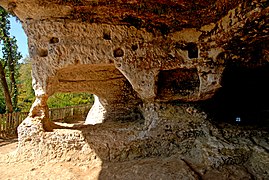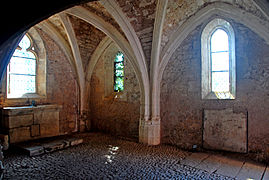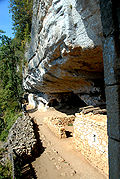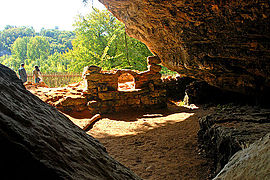Abri de la Madeleine
 La Madeleine rock shelter | |
 La Madeleine rock shelter location in France | |
| Alternative name | Magdalene rock shelter |
|---|---|
| Location | near Tursac, Dordogne département |
| Region | Aquitaine région, southwestern France |
| Coordinates | 44°58′05″N 1°01′44″E / 44.96806°N 1.02889°ECoordinates: 44°58′05″N 1°01′44″E / 44.96806°N 1.02889°E |
| History | |
| Periods | Upper Palaeolithic, |
| Cultures | Magdalenian |
| Associated with | European early modern humans |
| Site notes | |
| Excavation dates | 1875 |
| Archaeologists | Édouard Lartet, Henry Christy |

The archaeological site Abri de la Madeleine (Magdalene Shelter) is a rock shelter under an overhanging cliff situated near Tursac, in the Dordogne département of the Aquitaine Région of South-Western France. It represents the type site of the Magdalenian culture of the Upper Paleolithic.[1] The Bison Licking Insect Bite, a 20,000 year old carving of exceptional artistic quality, was excavated at the site. The shelter was also occupied during the Middle Ages. The medieval castle of Petit Marsac stands on the top of the cliff just above the shelter.[2] An engraved bone rod from the cave, depicting a lioness licking the opening of either a gigantic human penis or a vulva, shows the first documented act of bestiality.[3]
Excavations[]
Édouard Lartet, financed and helped by the Englishman Henry Christy, were the first systematic excavators of the site, starting in 1863, and published their findings in 1875 under the name of the Age of the Reindeer ("L'âge du renne"). Objects that were found at the la Madeleine site are distributed among a number of museums, including the Muséum de Toulouse, the Musee des Antiquites Nationales, St. Germain-en-Laye and the British Museum.
Gallery[]
References[]
- ^ Brian M. Fagan. "History of Archaeology Before 1900". Oxfordreference. Retrieved March 1, 2019.
- ^ "What is prehistoric art?". online art center. Retrieved March 1, 2019.
- ^ Podberscek, Anthony; Beetz, Andrea, eds. (2005). Bestiality and Zoophilia: Sexual Relations with Animals. ISBN 978-1557534125.
Further reading[]
- Laming-Emperaire, Annette. Origines de l'archéologie préhistorique en France, 1964.
External links[]
| Wikimedia Commons has media related to Abri de la Madeleine. |
- Prehistoric sites in France
- Archaeological type sites
- Monuments historiques of Dordogne
- European archaeology stubs
- Dordogne geography stubs














